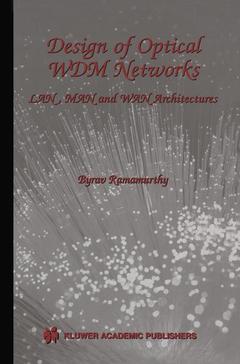Description
Design of Optical WDM Networks, Softcover reprint of the original 1st ed. 2001
LAN, MAN and WAN Architectures
The Springer International Series in Engineering and Computer Science Series, Vol. 603
Author: Ramamurthy Byrav
Language: English
Subject for Design of Optical WDM Networks:
Keywords
ATM; Asynchronous Transfer Mode; Broadcast; Internet; LAN; MAN; Potential; WAN; architecture; communication; design; model; network; switch; transmission
Design of Optical WDM Networks
Publication date: 10-2012
166 p. · 15.5x23.5 cm · Paperback
Publication date: 10-2012
166 p. · 15.5x23.5 cm · Paperback
Approximative price 105.49 €
Subject to availability at the publisher.
Add to cart
Design of WDM networks : LAN, MAN and WAN architectures
Publication date: 01-2001
166 p. · 15.5x23.5 cm · Hardback
Publication date: 01-2001
166 p. · 15.5x23.5 cm · Hardback
Description
/li>Contents
/li>Comment
/li>
Lo, soul! seest thou not God's purpose from the first? The earth to be spann'd, connected by net-work From Passage to India! Walt Whitman, "Leaves of Grass", 1900. The Internet is growing at a tremendous rate today. New services, such as telephony and multimedia, are being added to the pure data-delivery framework of yesterday. Such high demands on capacity could lead to a "bandwidth-crunch" at the core wide-area network resulting in degra dation of service quality. Fortunately, technological innovations have emerged which can provide relief to the end-user to overcome the In ternet's well-known delay and bandwidth limitations. At the physical layer, a major overhaul of existing networks has been envisaged from electronic media (such as twisted-pair and cable) to optical fibers - in the wide area, in the metropolitan area, and even in the local area set tings. In order to exploit the immense bandwidth potential of the optical fiber, interesting multiplexing techniques have been developed over the years. Wavelength division multiplexing (WDM) is such a promising tech nique in which multiple channels are operated along a single fiber si multaneously, each on a different wavelength. These channels can be independently modulated to accommodate dissimilar bit rates and data formats, if so desired. Thus, WDM carves up the huge bandwidth of an optical fiber into channels whose bandwidths (1-10 Gbps) are compati ble with peak electronic processing speed.
1. Introduction.- 1.1 Optical Networks and WDM.- 1.2 Focus of This Book.- 1.3 Book Outline.- 2. Optical Network Devices.- 2.1 Introduction.- 2.2 Optical Fiber.- 2.3 Optical Amplifiers.- 2.4 Switching Elements.- 2.5 Physical Layer Issues and Limitations.- 2.6 Conclusion.- I LAN/MAN Architectures.- 3. Optimizing Amplifier Placements: The Equally-Powered Wavelengths Case.- 4. Optimizing Amplifier Placements: The Unequally-Powered Wavelengths Case.- II WAN Architectures.- 5. Wavelength Conversion.- 6. Impact of Transmission Impairments.- 7. Conclusions.- Appendices.- Switch Model.- EDFA Model.- References.
'The field of optical WDM networks has experienced widespread attention and growth in recent years. This book, I believe, will be a welcome addition to the literature focusing on this exciting technology!'From the Foreword by Professor Biswanath Mukherjee, University of California
© 2024 LAVOISIER S.A.S.



